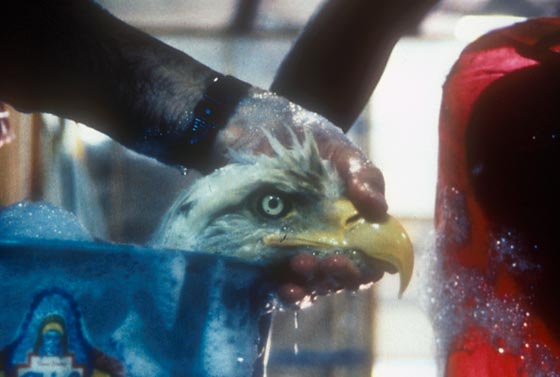
<a href="http://www.ibrrc.org/Exxon_Valdez_spill_1989.html" target="new">International Bird Rescue Research Center</a>
So what happens 20 years after 10 million gallons of heavy crude oil hit the delicate interface between land and sea in Alaska? First off, most everyone who doesn’t live there has forgotten. But what about the landscape and seascape—is all forgotten there too?
Ten years after the fact, the final dead-bird tally came in at between 100,000 and 700,000 birds killed, reports Nature. Good news: many species have recovered since then. Others are still recovering. Bad news: the Pigeon Guillemot has not.
The what, you ask. Oh, just those little pigeon-sized birds of the high latitudes who can fly in the air, fly underwater, dive to 150 feet below the surface in near-darkness, root around on the bottom for two minutes and actually find things to eat, survive the winter among the ice in subfreezing air temperatures, in water temperatures below the freezing threshold of freshwater, live without ever drinking freshwater, sleep on the water in ferocious Arctic storms… You know, those one-of-a-kind things that make a species unlike any other species.
The Exxon Valdez Oil Spill Trustee Council categorizes human services—fishing, recreation, and subsistence use—as still only recovering.
A few positive developments as a result of the Exxon Valdez disaster:
- Experiments in Prince William Sound led to groundbreaking bioremediation methods, notably using the bacterium Pseudomonas aeruginosa to break down oil. (Much better than detergents that are as toxic as oil.) Yay, bacteria!
- Exxon Mobil Corp tried to claim that some of the spilled oil was not its oil. In response, scientists bombproofed the art of hydrocarbon fingerprinting, assuring no one will easily dodge their own unctuous provenance again.
- The US Coast Guard tightened its chains of command and retrained its clean-up teams for oil spills.
- Congress passed the Oil Pollution Act of 1990, defining fiscal and clean-up responsibilities.
- Single-hulled tankers—like the Exxon Valdez—are now barred from US ports. France and Spain—with their own disastrous oil-spill history—won’t allow them within 200 miles of their coast.
The bad news:
- The single-hulled Exxon Valdez was repaired, sold, renamed the Mediterranean and is still plying Asian waters.
- Herring have not recovered since the spill. The problem could derive from the spill. Or it could be from overfishing. Or from ecosystem shifts. Or from an ugly combination of all.
- Surface puddles of Valdez crude oil can still be found.
- Pockets of undegraded oil rest just below the surface of some beaches, where sea otters dig for food.
- Last year the US Supreme Court eviscerated the financial punishment to Exxon Mobil by lowering the punitive damages from $2.5 billion to $507.5 million. The court judged the initial award as excessive under maritime law.
Sounds like we need a Planet Earth law that accurately reflects the costs of ecosystem services, one that even a high court sequestered far from the wild can understand.
Any Alaskans out there want to tell us what else it looks like on the ground or in the water 20 years on?










